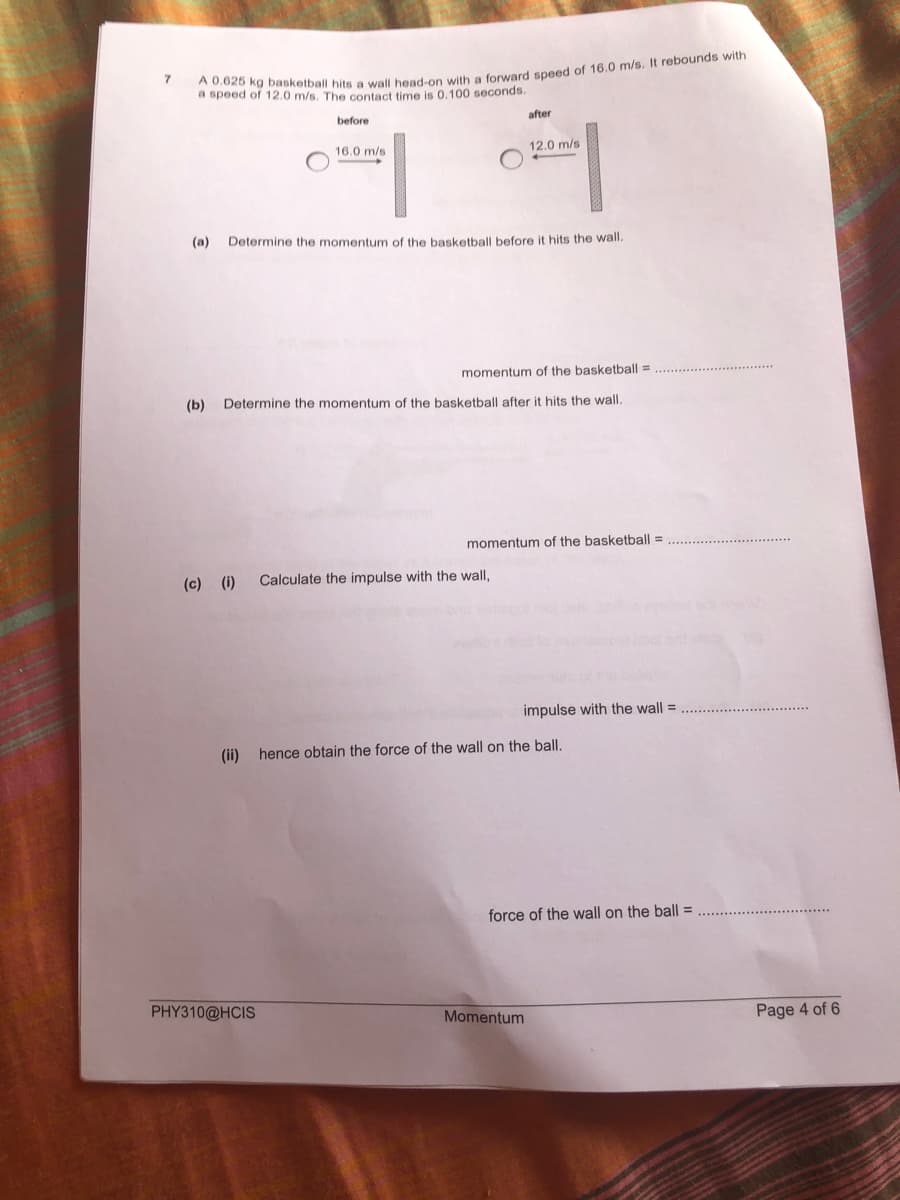a speed of 12.0 m/s. The contact time is 0.100 seconds. before after 16.0 m/s 12.0 m/s (a) Determine the momentum of the basketball before it hits the wall. momentum of the basketball = (b) Determine the momentum of the basketball after it hits the wall. momentum of the basketball = (c) (i) Calculate the impulse with the wall, impulse with the wall = (ii) hence obtain the force of the wall on the ball. force of the wall on the ball =
a speed of 12.0 m/s. The contact time is 0.100 seconds. before after 16.0 m/s 12.0 m/s (a) Determine the momentum of the basketball before it hits the wall. momentum of the basketball = (b) Determine the momentum of the basketball after it hits the wall. momentum of the basketball = (c) (i) Calculate the impulse with the wall, impulse with the wall = (ii) hence obtain the force of the wall on the ball. force of the wall on the ball =
Principles of Physics: A Calculus-Based Text
5th Edition
ISBN:9781133104261
Author:Raymond A. Serway, John W. Jewett
Publisher:Raymond A. Serway, John W. Jewett
Chapter8: Momentum And Collisions
Section: Chapter Questions
Problem 11P
Related questions
Question

Transcribed Image Text:a speed of 12.0 m/s. The contact time is 0.100 seconds.
after
before
12.0 m/s
16.0 m/s
(a)
Determine the momentum of the basketball before it hits the wall.
momentum of the basketball =
(b)
Determine the momentum of the basketball after it hits the wall.
momentum of the basketball =
(c) (i)
Calculate the impulse with the wall,
impulse with the wall =
(ii) hence obtain the force of the wall on the ball.
force of the wall on the ball =
PHY310@HCIS
Momentum
Page 4 of 6
![Figure below shows
a new car.
dummy of mass 70 kg used in a crash test to investigate the safety of
passenger
compartment
barrier
dummy
windscreen
The car approaches a solid barrier at 20 m/s. It crashes into the barrier and stops suddenly.
(a)
(i)
Calculate the momentum of the dummy immediately before the crash.
momentum =
[2]
(ii)
Determine the impulse that must be applied to the dummy to bring it to rest.
impulse =
[1]
(Ь)
In the crash test, the passenger compartment comes to rest in 0.20 s.
Calculate the deceleration of the passenger compartment.
deceleration =
[2]
The seat belt and air bag bring the dummy to rest so that it does not hit the windscreen.
The dummy has an average deceleration of 80m/s?.
(c)
Calculate the average resultant force applied to the dummy, of mass 70 kg.
force =
[2]
PHY310@HCIS
Momentum
Page 5 of 6](/v2/_next/image?url=https%3A%2F%2Fcontent.bartleby.com%2Fqna-images%2Fquestion%2Fb58474c4-52a5-4c83-89a9-a419f038194c%2F9023b215-e77c-4043-a420-c7072bf40c80%2F4bah665_processed.jpeg&w=3840&q=75)
Transcribed Image Text:Figure below shows
a new car.
dummy of mass 70 kg used in a crash test to investigate the safety of
passenger
compartment
barrier
dummy
windscreen
The car approaches a solid barrier at 20 m/s. It crashes into the barrier and stops suddenly.
(a)
(i)
Calculate the momentum of the dummy immediately before the crash.
momentum =
[2]
(ii)
Determine the impulse that must be applied to the dummy to bring it to rest.
impulse =
[1]
(Ь)
In the crash test, the passenger compartment comes to rest in 0.20 s.
Calculate the deceleration of the passenger compartment.
deceleration =
[2]
The seat belt and air bag bring the dummy to rest so that it does not hit the windscreen.
The dummy has an average deceleration of 80m/s?.
(c)
Calculate the average resultant force applied to the dummy, of mass 70 kg.
force =
[2]
PHY310@HCIS
Momentum
Page 5 of 6
Expert Solution
This question has been solved!
Explore an expertly crafted, step-by-step solution for a thorough understanding of key concepts.
Step by step
Solved in 4 steps with 3 images

Knowledge Booster
Learn more about
Need a deep-dive on the concept behind this application? Look no further. Learn more about this topic, physics and related others by exploring similar questions and additional content below.Recommended textbooks for you

Principles of Physics: A Calculus-Based Text
Physics
ISBN:
9781133104261
Author:
Raymond A. Serway, John W. Jewett
Publisher:
Cengage Learning

College Physics
Physics
ISBN:
9781305952300
Author:
Raymond A. Serway, Chris Vuille
Publisher:
Cengage Learning

Physics for Scientists and Engineers, Technology …
Physics
ISBN:
9781305116399
Author:
Raymond A. Serway, John W. Jewett
Publisher:
Cengage Learning

Principles of Physics: A Calculus-Based Text
Physics
ISBN:
9781133104261
Author:
Raymond A. Serway, John W. Jewett
Publisher:
Cengage Learning

College Physics
Physics
ISBN:
9781305952300
Author:
Raymond A. Serway, Chris Vuille
Publisher:
Cengage Learning

Physics for Scientists and Engineers, Technology …
Physics
ISBN:
9781305116399
Author:
Raymond A. Serway, John W. Jewett
Publisher:
Cengage Learning

Classical Dynamics of Particles and Systems
Physics
ISBN:
9780534408961
Author:
Stephen T. Thornton, Jerry B. Marion
Publisher:
Cengage Learning

Physics for Scientists and Engineers with Modern …
Physics
ISBN:
9781337553292
Author:
Raymond A. Serway, John W. Jewett
Publisher:
Cengage Learning

College Physics
Physics
ISBN:
9781285737027
Author:
Raymond A. Serway, Chris Vuille
Publisher:
Cengage Learning